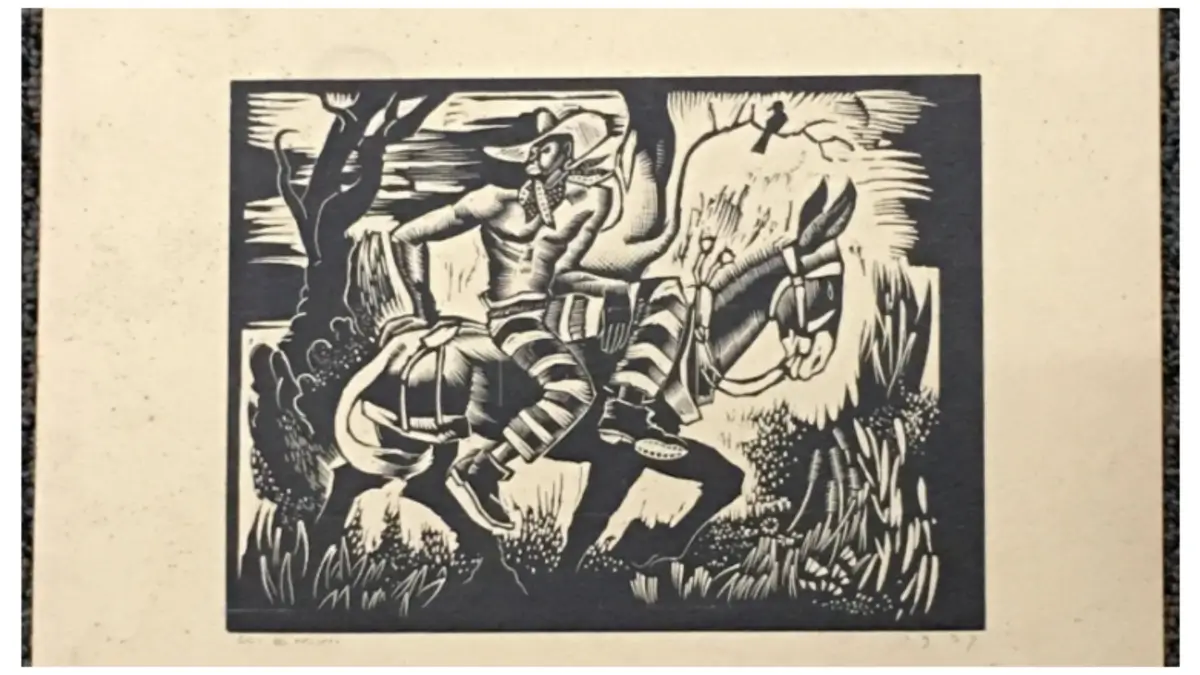When it comes to art heists, the most successful tactic for one man was to hide in plain sight.
There was never a need to sneak through a museum window for one of America’s most prolific living art forgers Earl Marshawn Washington. He tricked American and French collectors out of hundreds of thousands of dollars by selling counterfeit woodcuts passed off as rare Renaissance-era works.
In fact, prosecutors in court conceded that 61-year-old was a “skilled artist” himself. Some of his art work is still featured on Invaluable.com.
His woodcuts were so masterful, collectors believed for years that they were created in the 15-century during a period known for cultural evolution.

On April 2, 2024, after at least 30 years on the art scene, the law caught up to Washington, and he was sentenced to over four years in prison. His decades-long con had finally ended.
Washington got his start in the late 1990s when he began selling woodcuts on eBay that he claimed were made by a little-known Black artist named Earl Mack Washington — who happened to be his great-grandfather.
The elder Washington, a “master wood-engraver and printer,” had supposedly accumulated a phenomenal collection of woodblocks from famous friends during his lifetime (1862 – 1952), and now his great-grandson was raking in the cash, selling tens of thousands of woodblock prints on eBay and through galleries in San Francisco and Detroit, among other places.
The pieces were reasonably priced, usually from $20 to $350, and printed on old paper. The elder Washington’s elaborate bio also threw off suspicion.
The bio said the late Washington “had one of the largest collections of artists’ woodblocks in the United States,” which he had acquired through a “circle of acquaintanceship” that included Eric Kill, Lynd Ward, Rockwell Kent, M. C. Escher, and Robert Gibbings.
“Washington’s career began at the age of 13, when he was apprenticed at a Southern printing shop. In 1880 Washington moved to New York, but encountered racial and social prejudice which barred him from employment at the larger printing shops in the city. Eventually finding a position in a small shop on the Lower East Side, Washington went on to perfect his skills as a master printer,” read the well-crafted bio.
Rumors had been swirling around Earl Marshawn Washington since at least 2004, when Forbes spotlighted the controversial character.
The article, in which he’s described as “handsome” and “such a good liar,” discusses the accusations of fraud against him by art dealers and lawyers. An ex-girlfriend came forward, Terra Zavala, who wrote in a signed statement that the legendary great-grandfather was made up and Washington had tried to pull her into his scheme.
By then, he had already admitted to creating hundreds of prints with a team of assistants he trained to cut woodblocks. But he stuck to his story about his great-grandfather in the Forbes article, saying he never misrepresented his work.
Around that time, the estate of M. C. Escher detected what it said were fraudulent prints sold by Washington and pressured eBay to ban him. The estate filed a criminal fraud complaint in California, where prints were handled by a stripper named Stacy Ortiz, Washington’s third wife.
Another criminal complaint was filed in Kalamazoo County, Michigan, by the owners of Prairie Home Antiques, who had purchased 82 prints from Washington for $1,640 in 2004.
By the time of his guilty plea in July 2023, Washington had confessed to enlisting several romantic partners into his dark web going back to 2013.
It’s no surprise that when he was indicted, his then-wife Zsanett Nagy, a 32-year-old from Hungary, was also charged. In recent years, the two had upped the ante and were now trading in even “rarer” Renaissance-era woodblocks dating back to the 15th century that brought much higher profits. Now dealing with international buyers, he developed a jaunty alias, calling himself “River Seine.”
In one instance, French buyers funneled nearly $85,000 through PayPal to “River Seine” for pieces described as “15th.C Reformation/Lutheran wood blocks.” His wife Nagy moved the proceeds to a bank account in her name and then quickly made several withdrawals in cash, according to the U.S. Attorney’s Office.
Washington was finally caught, thanks to the work of the FBI’s dedicated Art Crime Team. He was never one to stay anywhere long, living in Honolulu, Key West, Las Vegas, and other places, which may have encumbered investigations through the years. The statute of limitations for art fraud varies state-by-state. In Hawaii, for instance, it’s just four years.
In January 2023, Washington and Nagy were initially charged with conspiracy to commit wire fraud, bank fraud, and money laundering. Washington was also indicted on separate bank fraud and conspiracy to commit bank fraud charges.
As part of a plea agreement, the original charges against Washington were dismissed, and a new charge of conspiracy to commit wire fraud and mail fraud was filed.
After pleading guilty in July, he was sentenced last month to over four years in prison and ordered to pay restitution to victims in the total amount of $203,240.90, likely far less than the amount he earned over his decades-long heist. He was given a three-year term of supervised release after his imprisonment.
Nagy pleaded guilty in August 2023 to conspiracy to commit wire fraud, mail fraud, and money laundering. The Hungarian national received a two-year prison sentence, was ordered to pay approximately $107,000 in restitution, and could face deportation.
Lori J. Ulrich, the federal public defender representing Washington, has not spoken to the press, but in court filings, she repeatedly called Washington “complicated” and “his own worst enemy,” according to USA Today.
Ironically, his personal work is still owned by galleries today. His decades-long art scheme ensnared multiple exes, art buyers, artists’ estates, and FBI sleuths, but it has finally unraveled.


